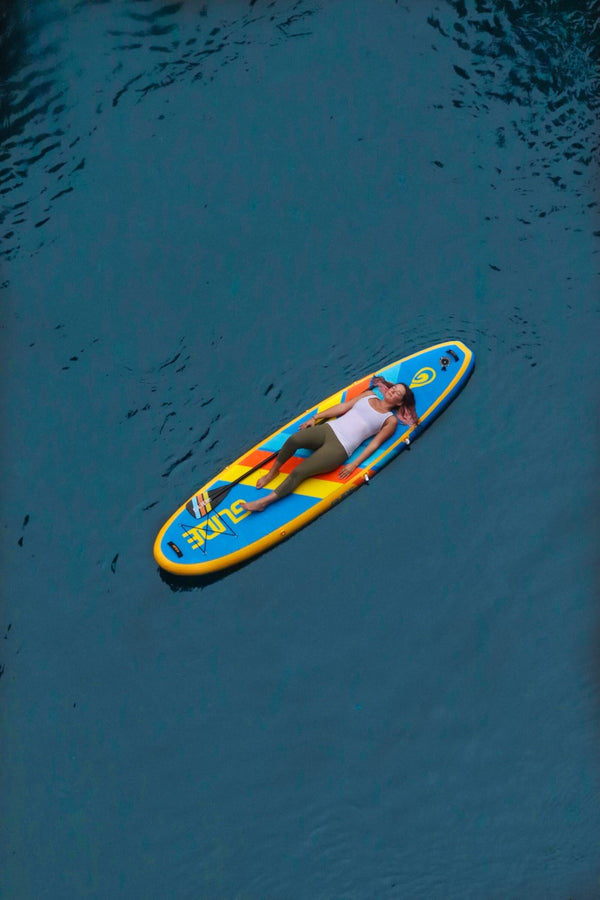
Everything You Need to Know About Flat Water Paddle Boarding
Stand Up Paddle Boarding comes with a lot of lingo and paddlers with an intense love for all things paddle boards.
It can become intimidating to ask, and we're here to help you skip that step!
Here's everything you need to know about flat water paddle boarding.
Paddle boarding, a sport where the tranquility of water meets the thrill of balance, isn't just an activity; it's an experience. At Glide SUP, we're not just selling paddle boards; we're offering an entry into a world where every stroke through the water is a stroke towards adventure. Whether you're skimming the ocean's surface, navigating the calm of a lake, or exploring the gentle flow of a river, paddleboarding opens up a universe of possibilities.

The Essence of Flat Water Paddle Boarding
Flat water SUP, or stand up paddle boarding, is where serenity and sport collide. It’s the perfect setting for those new to paddle boarding or seasoned paddlers seeking peace on the water's surface. Glide SUP stands at the forefront, offering the O2 Retro—an all-around inflatable paddle board designed for the ultimate flat water experience. This board combines stability, durability, and a lightweight design, making it ideal for everyone from beginners to advanced paddlers.
Choosing Your Companion: The O2 Retro Inflatable Paddle Board
The O2 Retro, our flagship flat water paddle board, is a marvel of design and functionality. Engineered for stability and ease, it’s the go-to for activities like leisure paddling, exploration, SUP picnics, and even taking your furry friend along for the ride. Its beginner-friendly design doesn't compromise on performance, making it the perfect choice for anyone looking to glide effortlessly across flat waters.
From Leisure to Adventure: Activities for Every Paddler
Flat water paddle boarding with Glide SUP isn't just about paddling; it's about the experiences you curate. Whether it's a tranquil solo journey, a fun outing with friends and family, or an adventurous SUP camping trip, the possibilities are as vast as the waters you'll explore. Our boards are crafted to enhance every moment, ensuring that your time on the water is nothing short of extraordinary.
The Technical Edge: What Makes Glide Stand Out?

Our commitment to excellence is reflected in every board we design. The O2 Retro, with its all-around capabilities, offers unparalleled stability, courtesy of its meticulously crafted dimensions and drop-stitch construction. Unlike the fleeting durability of single-layer boards found elsewhere, Glide SUP boards boast three-layer construction, ensuring they outlive even the grandest of adventures.
Embracing Every Wave: Glide SUP in Choppy Waters
While flat water is our playground, our boards are no strangers to the challenge of choppy conditions. The versatility of our designs means that whether the water is as calm as a sleeping lake or as temperamental as the sea at dawn, your Glide board is ready to take on the challenge, offering stability, speed, and agility.
Everywhere You Go: The Portability of Inflatable SUPs
One of the greatest joys of paddle boarding is the freedom to explore new waters. Glide SUP boards, with their inflatable design, are your passport to adventure. Easy to transport and set up, your next paddle boarding journey is just a backpack away, whether it's a remote mountain lake or the vast expanse of the ocean.
Paddleboarding: A Gateway to Health and Happiness
Beyond the thrill and tranquility, paddle boarding stands as a bastion of health benefits. It's a full-body workout that engages every muscle, offering a blend of aerobic and anaerobic exercise that enhances fitness and well-being. Glide SUP boards are designed to maximize these benefits, making every paddle stroke a step towards a healthier you.
Join the Glide Family

As we conclude this journey through the essence of flat water paddle boarding, it's clear that this sport offers more than just a physical activity—it's a pathway to experiences, adventures, and memories. With Glide SUP, you're not just choosing a board; you're choosing a lifetime of adventures on the water.
Ready to dive into the world of paddle boarding? Visit us at Glidesup.com or reach out at info@glidesup.com. Let's make waves together.
Related Topics
Everything You Need to Know About All Around Paddle Boards
Health Benefits of Paddle Boarding
How Inflatable Paddle Board Technology Changed The SUP Industry
Your Comprehensive Guide to Inflatable Stand Up Paddle Boards


